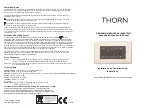
Glossary 330
functional levels (Windows Server™ 2003)
Windows Server™ 2003 expands on the domain mode concept introduced in Windows® 2000 (see
Mixed Domain Mode and Native Domain Mode). Functional levels apply to both forests and domains.
Like the domain mode, functional levels limit what type of operating systems can run on domain
controllers in a domain or forest. Each functional level also has an associated list of features that become
available when the domain or forest reaches that particular functional level. Functional levels become
relevant in a domain and forest when the first domain controller running Windows Server™ 2003 is
added to a domain. By default the domain functional level is set to "Windows 2000 Mixed," and the
forest functional level is set to "Windows 2000." Functional levels can be set using the ADUC snap-in.
Like domain mode, after a functional level has been elevated to a higher status, it cannot be changed
back.
global catalog
Contains a partial replica of every object in every domain in the forest. The GC enables users and
application to find objects in the active directory forest given one or more attributes of the target object. It
also contains the schema and configuration of Directory partitions. This means the GC holds a replica of
every object in the active directory, but with only a small number of attributes. The attributes in the GC
are those most frequently used in search operations (such as a user's first and last names, log on names,
and so on). The GC enables users to find objects of interest quickly without knowing what domain holds
them and without requiring a contiguous extended name space in the enterprise. The GC is built
automatically by the active directory replication system. Attributes can be easily added to the GC content
by active directory administrators.
interim functional level
A Windows Server™ 2003 configuration of active directory that allows it to coexist in a domain that
includes one or more Windows NT® 4.0 BDCs. See also functional levels.
LDAP Display Name
The name by which LDAP clients identify a specific attribute in an abject. The LDAP Display Name is also
an attribute in its own right and is a mandatory item in each active directory object. The LDAP Display
Name for an attribute contains no spaces or hyphens and the first letter is always lowercase while each
distinct word in the name begins with a capital letter (for example, sAMAccountName, givenName, cn,
sn). The lDAPDisplayName attribute value for each object is normally made by capitalizing the first letter
of each word in the Common Name, then removing the hyphens and concatenating all the words
together (and making the first letter lowercase). See also attribute.
LDAP-enabled directory service
A distributed network directory service that has native support for LDAP.
Lightweight Directory Access Protocol
A protocol used to access a directory service such as active directory that has been enabled to
understand the protocol. LDAP is a simplified version of the DAP developed as part of the X.500
international standard for directory services. While LDAP is certainly a computer communication protocol,
the term "LDAP" is frequently used to denote more than just the protocol standard: it is inextricably tied to
a default schema for the active directory database and other essential aspects of interoperability.
Summary of Contents for 1x1x16 - IP Console Switch KVM
Page 1: ...HP IP Console Viewer User Guide Part Number 409053 003 July 2008 Third Edition ...
Page 50: ...Managing KVM console switches 50 Unlocking an account 1 Select Users ...
Page 176: ...Organizing the system 176 Serial console switch General tab Server General tab ...
Page 181: ...Organizing the system 181 KVM console switch Network tab Serial console switch Network tab ...
Page 259: ...Using the on board Web interface OBWI 259 5 Click Save ...
Page 264: ...Troubleshooting 264 2 Select Install Certificate ...
Page 268: ...Troubleshooting 268 3 Select Install Certificate ...
Page 296: ...LDAP client behavior overview 296 ...










































